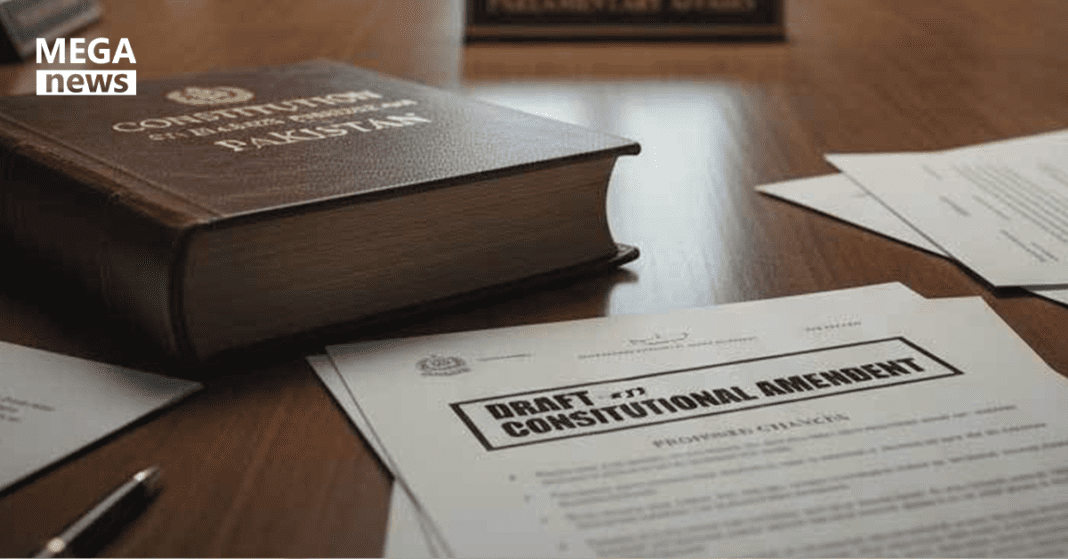What is the 27th Constitutional Amendment — a clear summary
How would Pakistan’s 27th Amendment reshape its military and courts? is a sweeping package of constitutional changes passed by Pakistan’s parliament in November 2025 that alters the country’s defence command structure, creates a new Federal Constitutional Court, and changes the process by which judges and top officials are appointed and reviewed. The package reassigns some constitutional powers previously exercised by the Supreme Court to the newly created court, and it elevates the authority of the Army Chief by enabling a new top-level command office that brings the Army, Navy and Air Force under a more concentrated chain of command. Those two pillars — military command reshaping and judicial restructuring — are the axis on which the amendment pivots, with additional tweaks to criminal jurisdiction, transfer rules for judges, and legal immunities for some office-holders.
How the amendment changes Pakistan’s military command structure
At the heart of the defence reforms is a constitutional redesign that creates a senior integrated command office often described in media coverage and the bill text as the Chief of Defence Forces (or equivalent integrated role) with expanded operational authority across the army, navy and air force. Practically, this means the Army Chief — the individual holding the most influential military post in Pakistan’s history of civil-military politics — gains constitutionally guaranteed precedence to coordinate and issue directives across the services, a structural shift that centralises military decision-making and reduces service autonomy and the checks that flowed from a more segmented command. The amendment also aligns defence-related Acts (such as amendments to the Pakistan Navy Act, Pakistan Air Force Act and related regulations) with the new constitutional design, which lawmakers said is intended to modernise “jointness” in defence operations but critics argue will formalise dominance rather than balance.
Those changes are not merely organizational: the amendment also includes provisions that, according to its enacted text and government briefings, grant post-term legal protections and immunities to specified office-holders and redefine disciplinary and accountability mechanisms for top defence leaders. In short, the package converts previously conventional political influence into constitutional authority — shifting the baseline power in favour of a single top defence figure and expanding the executive’s role in defence governance. That shift has direct implications for civilian oversight, because the formal instruments that used to check or coordinate the top military office are now subsumed into this new constitutional structure.
How the amendment reshapes the judiciary and constitutional review
Equally consequential is the judicial overhaul embedded in the amendment: it creates a Federal Constitutional Court that takes over many of the constitutional review functions that the Supreme Court traditionally held. According to the bill’s language and parliamentary debate, the new court’s judges will be appointed under revised processes, granting the executive and Parliament greater influence over the selection of judges who will now decide constitutional conflicts that were previously within the Supreme Court’s domain. Critics — from leading jurists to rights groups — warned that moving constitutional jurisdiction out of the Supreme Court and into a newly structured court risks subordinating judicial independence to political influence. The critics also argued that the amendment’s timelines and appointment rules create first-mover advantages: the initial bench and institutional architecture will be shaped under conditions favouring the sitting government and its allied institutions.
The amendment’s reallocation of constitutional jurisdiction goes beyond semantics: it changes where citizens can file constitutional petitions, who decides what counts as a constitutional breach, and how judicial review interacts with executive decisions. The immediate consequence is predictable: a reduced capacity for the Supreme Court to act as a counter-majoritarian check on executive or military interventions. That institutional change has cascading effects on high-stakes litigation — from electoral disputes to emergency powers and high-level corruption cases — because the new legal architecture will shape precedents and procedural access for years to come.
Legal mechanics: which articles were amended and how the bill moved through Parliament
The 27th amendment is a package that amends multiple articles of the Constitution; when introduced in the Senate it included changes to Article 42 (executive authority), Article 243 (control of the armed forces), and several clauses dealing with the federal judiciary and transfer rules for judges. The bill was tabled in the Senate by the Law Minister and fast-tracked through both houses in November 2025, secured a two-thirds majority in line with Article 239’s requirements for constitutional amendments, and received presidential assent to become law. The official bill documents and the Senate’s published text show that the amendment was presented as an integrated “modernisation” and “institutional realignment” package, while parliamentary records show opposition boycott or reduced participation in several votes, which opponents and independent observers say narrowed deliberation.
This legislative path matters because constitutional entrenchment — a two-thirds vote in both houses — gives the amendment durability; reversing such a change would require another supermajority or a future political consensus that is hard to predict. Legal scholars note that once appointment and jurisdiction rules are embedded in constitutional text, administrative and legislative reversal becomes legally possible but politically difficult, a point that underlines the amendment’s long-term significance for institutional checks and balances.
Immediate political winners and losers — the power map
Who benefits most? At a glance, the main winners appear to be the sitting executive and the military’s top leadership: the amendment codifies expanded authority and immunities in ways that materially increase their bargaining power vis-à-vis other state institutions. The government argued that the package stabilises decision-making, streamlines national security leadership, and protects state functionaries from “frivolous” legal harassment after they leave office. Opponents counter that those very protections insulate officials from accountability for abuse or corruption and shift the balance away from parliamentary scrutiny and judicial review.
Political losers include opposition parties that boycott votes and civil institutions that rely on an independent judiciary to mediate high-stakes conflicts. The provinces are also among potential losers if fiscal or administrative tweaks inside the package reduce the practical scope of autonomy established under the 18th Amendment. Some provincial governments have already expressed formal displeasure, calling the changes a rollback of provincial rights and an overreach by a centralising federal government.
Domestic reactions: politicians, judges, civil society and provinces
Reaction has been polarized and intense. Senior opposition leaders and PTI have described the amendment as an “attack on the constitutional structure” and vowed protests and legal challenges. Prominent jurists and two serving judges publicly resigned in protest shortly after the amendment’s passage, framing the package as a systemic threat to the independence of the judiciary and the rule of law. Human rights organizations and bar associations issued condemnations, while international rights bodies expressed concern about the implications for due process and separation of powers. Government supporters and coalition partners defended the package as necessary institutional reform and an answer to perceived instability created by frequent judicial interventions in politics.
Provincial governments, particularly those led by opposition parties, have articulated fears that the amendment erodes the devolution model established by the 18th Amendment. Those actors warn of an erosion of fiscal autonomy and administrative prerogatives, and they are likely to pursue both political mobilisation and legal avenues to contest the changes. Whether provinces will coordinate an effective multilateral pushback will depend on political alignments and the capacity to sustain public pressure against a consolidated federal majority.
Regional and international implications: security, alliances and investor confidence
A constitutional change that consolidates military command and reduces judicial independence has immediate geopolitical signalling. For regional neighbours and strategic partners, the amendment suggests that Pakistan is moving to a more centralised decision-making model in defence matters — a fact that could matter for military cooperation, joint exercises, and diplomacy. Neighbouring capitals, international financial institutions and foreign investors will monitor whether the new legal protections for office-holders translate into a safer or riskier investment climate. Some investors might view clearer chains of command as lowering operational uncertainty in security policy; others will view reduced judicial independence and increased risk of arbitrary governance as a deterrent for rule-of-law-sensitive investments. International human rights and legal communities have already flagged concerns, and diplomatic responses will likely be calibrated between public statements and closed-door diplomacy.
Scenarios going forward: how hard is reversal, and what paths of challenge remain
Reversing a constitutional amendment is legally straightforward in form — another two-thirds majority in Parliament can amend the Constitution again — but politically hard in practice. The more immediate avenues for challenge are judicial (constitutional petitions questioning procedural defects, claims of violation of “basic structure” doctrine), political (mass protest campaigns, provincial assemblies pressing specific grievances), and electoral (voters holding incumbents to account in future elections). Yet each path is constrained: the amendment itself reshapes the judicial architecture that would hear many of those cases, and the political space for sustained opposition will be tested by the state’s control over security and institutions. That is why many analysts say the amendment’s passage likely tilts the balance for the medium term unless there is a major political realignment or sustained mass mobilisation that forces a renegotiation.
There are also legal technicalities that could slow implementation — for example, transitional provisions, rules for the first appointments to the Federal Constitutional Court, and the detailed amendments to service acts that require parliamentary or executive regulations. Those implementation details create short windows where opposition forces or independent actors can litigate or lobby to shape the new institutions. But these windows are narrow and time-sensitive; whoever gets to set the initial institutional norms will carry a long-term advantage.
How this affects ordinary Pakistanis — services, rights and rule of law
For everyday citizens the amendment’s most tangible effects will be indirect but real: access to courts for fast and fair adjudication may be affected if the institutional independence of constitutional review is weakened, which in turn could influence outcomes in civil liberties cases, property disputes, or high-profile corruption trials. Service delivery — health, education, local governance — is more immediately linked to provincial authority and budgets; if the amendment’s accompanying tweaks reduce provincial fiscal autonomy, that could translate into slower or more centralised decision-making for local services. Additionally, perceptions of legal insecurity or arbitrariness can depress civic trust, raise emigration considerations among professionals, and affect the everyday calculus of business owners and investors who rely on predictable adjudication.
At a social level, when key institutions are perceived as less independent, minority communities, dissidents, and political opponents may feel heightened vulnerability to politicised prosecutions or administrative actions. Even the symbolic effect — that constitutional checks can be rewritten quickly — reshapes public expectations of how disputes will be resolved in the future. That change in expectations matters: law is as much about predictable process as it is about outcomes, and predictable institutions sustain confidence in markets, governance and civic life.
Conclusion
The 27th constitutional amendment in detail ,How would Pakistan’s 27th Amendment reshape its military and courts? is not a narrow technical reform — it is a structural reorientation of the Pakistani state. By centralising defence command and reassigning constitutional review, the amendment intensifies the executive-military axis while reducing some of the institutional checks that have shaped Pakistan’s political evolution. The short term will be defined by political contestation, legal challenges and implementation details; the medium term will test whether the new architecture produces stability or entrenches institutional imbalances that undermine democratic accountability. Either way, the amendment has raised the stakes for Pakistan’s constitutional order — and for the citizens and institutions that must adapt to a new balance of power.



